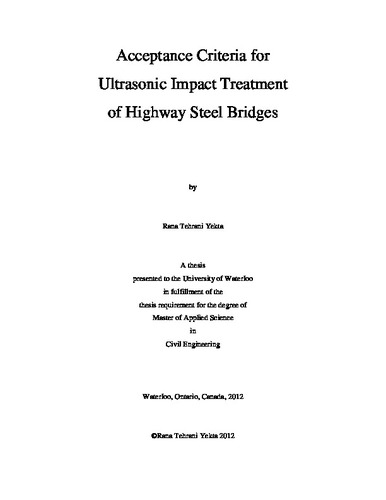| dc.description.abstract | The need for rehabilitation of bridges has become a critical challenge due to aging and an increase in traffic loads. Many of these bridges are exceeding their design fatigue life. Since many of these bridges are structurally deficient, they need to be rehabilitated or replaced by a new bridge. The most susceptible and weak parts of steel bridges to cracks and fatigue are the welds, due to the presence of high stress concentrations, tensile residual stresses, and imperfections as a result of the welding process. Inspection and repair of welds are difficult and elimination of welded details is not possible in steel bridge construction. Ultrasonic impact treatment (UIT) is a promising and innovative post-weld treatment (PWT) method for improving the fatigue performance of existing welded steel and steel-concrete composite structures such as highway bridges. The fatigue resistance of treated joints is enhanced by improving the geometry of the weld toe, and introducing compressive residual stresses. However, a lack of tools for quality assurance has slowed UIT’s adoption by bridge authorities.
The current study was undertaken to examine the fatigue performance of structural steel welds subjected to UIT at various levels, including intentional under-treatment and over-treatment, and to relate the fatigue performance of the treated welds to geometric and metallurgical properties measured to control the treatment quality. The last objective was to use the laboratory results to develop acceptance criteria for the quality control of UIT in bridge applications.
Fatigue tests of non-load carrying fillet welded attachments were conducted on properly treated, under-treated, and over-treated weld toes. Statistical analyses of the fatigue life data were performed and crack growth was monitored using the alternating current potential drop (ACPD) method. Measurement of local properties (such as weld toe geometry, local hardness, and residual stresses) and examination of the weld toe microstructure were also performed on the untreated and treated welds. The effects of weld toe geometry on the local stresses in the untreated and treated welds were also investigated using elastic finite element analysis (FEA) to obtain the stress concentration factor (SCF) for the different treatment cases and to examine the changes in the SCF for the different weld toe geometries.
Based on the statistical analysis performed in this research, the results illustrated that UIT significantly improved the fatigue lives of weld details regardless of the investigated level of treatment quality. The fatigue lives of welded details under constant amplitude (CA) loading and constant amplitude loading with under-loads (CA-UL) were increased up to 30 and 27 times respectively. On average, the fatigue life of the treated weld details was slightly lower under CA-UL than under CA loading. Treatment quality had little impact on the mean of the S-N curves. However, it did impact the design (95% survival probability) S-N curves, with the curve associated with a proper treatment slightly higher than the curves for poor or unknown treatment quality. Local near-surface microhardness and compressive residual stresses were greatest for the over-treated welded details, followed by the properly treated and then the under-treated welded details. Increasing the treatment speed resulted in a greater reduction in the surface microhardness and compressive residual stresses than decreasing the treatment intensity.
Finite element analyses showed that changes in weld toe geometry due to UIT can cause a decrease in the SCF near the surface of the treated weld toe. The SCF was the lowest for the properly treated steel specimens and slightly higher for the under-treated specimens. For the over-treated specimens, the SCFs were nearly as high as for the untreated weld. The SCF increases as the thickness of the flange increased up to 19 mm. With further flange thickness increase to 38 mm, the SCF did not change substantially.
The work presented herein demonstrated that indent depth measurements from the base metal side, commonly used for quality control, may not identify over-treatment on their own. Indent depth measurements from both the weld and the base metal sides, obtained by measurement of weld toe impressions, offer a good alternative means for identifying over-treatment. However, for identifying under-treatment, indent depth measurements should be used in conjunction with visual inspection for traces of the original weld toe. | en |

